International Journal of Intelligent Systems and Applications @ijisa
Статьи журнала - International Journal of Intelligent Systems and Applications
Все статьи: 1214
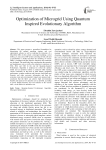
Optimization of Microgrid Using Quantum Inspired Evolutionary Algorithm
Статья научная
This paper presents a generalized formulation for determining the optimal operating strategy and cost optimization scheme as well as reducing the emissions of a MicroGrid (MG). In this article a microgrid including a wind turbine, pv array and a CHP system consisting of fuel cells and a microturbine is studied and then the modeling of various DERs is conducted and the objective functions and constraints are developed. The model takes into consideration the operation and maintenance costs as well as the reduction in emissions of NOx, SO2, and CO2 In the end the Quantum-Inspired Evolutionary Algorithm is employed to solved the optimal model and an operation scheme is achieved while meeting various constraints on the basis of tariff details, equipment performance, weather conditions and forecasts, load details and forecasts and other necessary information and then the economic costs and environmental impacts are analyzed and a conclusion that the QEA can achieve high environmental benefits and spend as low operation cost as possible. according to power Output functions and cost function of the various units , can be achieve to minimize cost.
Бесплатно
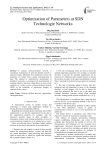
Optimization of Parameters at SDN Technologie Networks
Статья научная
A concept software-defined network is considered. Architecture of software-defined network is analyzed which, differently from traditional, foresee the separation of C-plane from a plane communication of data. The method of multicriterion optimization of multilevel networks is examined with determination of resulting objective function, which allows to carry out the synthesis of control system software-defined network (SDN) in the conditions of unforeseen changes of structure of the system.
Бесплатно
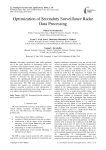
Optimization of secondary surveillance radar data processing
Статья научная
Secondary surveillance radar (SSR) performs one of the main functions of information service for consumers of the airspace control system. To improve the quality the SSR information is processed using modern information technology. The use of a consistent procedure for processing surveillance system data, due to the functionally completed stages of processing, made it possible to formalize the data processing procedure. However, this significantly limited, and in some cases excluded, the opportunities for inter-stage optimization of data processing. The SSR data processing structure synthesis and analysis are considered in this paper making it possible to perform a joint optimization of signal processing and primary processing of data, as well as to improve the quality of data processing.
Бесплатно
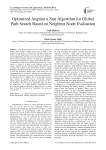
Optimized Angular a Star Algorithm for Global Path Search Based on Neighbor Node Evaluation
Статья научная
Any electromechanical device can be termed as Robot, which imitates human actions and in some of the situation can be used as a replacement for human. These days Robots are the integral part of our life and can be applied in several applications and tasks by giving respective commands. The research in robotics domain is to make it as autonomous and as much independent as it can be. The problem that arises is of controlling a mobile robot with the energy constraint. A lot of energy is wasted, if it takes wrong trajectory motion, this motion depends upon the robot knowledge which indeed in not constant. The variation in the environment results in making difficult for the robot to take precise and accurate measurements to reach the destination without much of the energy loss. An autonomous robot is expected to take decision according to the situation. For this precise decisions of robot path planning there are algorithms like A*, Dijkstra, D* etc. In this paper we have done analysis on partially known environment situation. Optimal path is planned by new heuristic approach over the A star algorithm, robot moving at an appropriate angle cuts down the unnecessary cost of path planning. Experimental results show that the proposed algorithm is much effective for more than 8% than the conventional A* algorithm in the same map environment.
Бесплатно
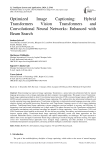
Статья научная
Deep learning has improved image captioning. Transformer, a neural network architecture built for natural language processing, excels at image captioning and other computer vision applications. This paper reviews Transformer-based image captioning methods in detail. Convolutional neural networks (CNNs) extracted image features and RNNs or LSTM networks generated captions in traditional image captioning. This method often has information bottlenecks and trouble capturing long-range dependencies. Transformer architecture revolutionized natural language processing with its attention strategy and parallel processing. Researchers used Transformers' language success to solve image captioning problems. Transformer-based image captioning systems outperform previous methods in accuracy and efficiency by integrating visual and textual information into a single model. This paper discusses how the Transformer architecture's self-attention mechanisms and positional encodings are adapted for image captioning. Vision Transformers (ViTs) and CNN-Transformer hybrid models are discussed. We also discuss pre-training, fine-tuning, and reinforcement learning to improve caption quality. Transformer-based image captioning difficulties, trends, and future approaches are also examined. Multimodal fusion, visual-text alignment, and caption interpretability are challenges. We expect research to address these issues and apply Transformer-based image captioning to medical imaging and distant sensing. This paper covers how Transformer-based approaches have changed image captioning and their potential to revolutionize multimodal interpretation and generation, advancing artificial intelligence and human-computer interactions.
Бесплатно
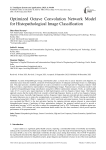
Optimized Octave Convolution Network Model for Histopathological Image Classification
Статья научная
Accurate histopathological image classification plays a crucial role in cancer detection and diagnosis. In automated cancer detection methods, extraction of histological features of malignant and benign tissues is a challenging task. This paper presents a modified approach on octave convolution to extract high and low-frequency features which help to provide a comprehensive representation of histopathological images. Proposed octave convolution model is used to perform histopathological image classification using three different optimization strategies. Firstly, an optimal alpha value of 0.5 is used to give equal importance to both high-frequency and low-frequency feature maps. This balanced approach ensures that the model effectively considers critical high-frequency features as well as low-frequency features of cancerous tissues. Secondly, high-frequency and low-frequency feature maps are extracted and down sampled into half the spatial dimension size to reduce the computational cost compared to standard CNN. Thirdly, training and validation was conducted using ReLU, PReLU, LeakyReLU, ELU, GELU and Swish activation functions. From the experiment, it was concluded that PReLU is the best activation function for capturing intricate patterns inherent in cancer-related histopathological images. Combining all these optimization strategies, the proposed method proved to provide a classification accuracy of 93% and also to reduce the computational cost by 50%. Performance validation against pre-trained models, CNN variants and vision transformer-based models has also been conducted, which proved superior performance of the proposed model.
Бесплатно
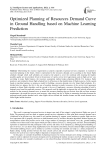
Optimized Planning of Resources Demand Curve in Ground Handling based on Machine Learning Prediction
Статья научная
Determining the resource requirements at airports especially in-ground services companies is essential to successful planning in the future, which is represented in the resources demand curve according to the future flight schedule, through which staff schedules are created at the airport to cover the workload with ensuring the highest possible quality service provided. Given in the presence of variety service level agreements used on flight service vary according to many flight features, the resources assumption method makes planning difficult. For instance, flight position is not included in future flight schedule but it's efficacious in the identification of flight resources. In this regard, based on machine learning, we propose a model for building a resource demand curve for future flight schedules. It is divided into two phases, the first is the use of machine learning to predict resources of the service level agreement required on future flight schedules, and the second is the use of implement a resource allocation algorithm to build a demand curve based on predicted resources. This proposal could be applicable to airports that will provide efficient and realistic for the resources demand curve to ensure the resource planning does not deviate from the real-time resource requirements. the model has proven good accuracy when using one day of flights to measuring deviation between the proposed model predict demand curve when flights did not include the location feature and the actual demand curve when flights include location.
Бесплатно
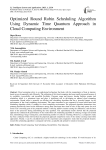
Статья научная
Cloud computing refers to a sophisticated technology that deals with the manipulation of data in internet-based servers dynamically and efficiently. The utilization of the cloud computing has been rapidly increased because of its scalability, accessibility, and incredible flexibility. Dynamic usage and process sharing facilities require task scheduling which is a prominent issue and plays a significant role in developing an optimal cloud computing environment. Round robin is generally an efficient task scheduling algorithm that has a powerful impact on the performance of the cloud computing environment. This paper introduces a new approach for round robin based task scheduling algorithm which is suitable for cloud computing environment. The proposed algorithm determines time quantum dynamically based on the differences among three maximum burst time of tasks in the ready queue for each round. The concerning part of the proposed method is utilizing additive manner among the differences, and the burst times of the processes during determining the time quantum. The experimental results showed that the proposed approach has enhanced the performance of the round robin task scheduling algorithm in reducing average turn-around time, diminishing average waiting time, and minimizing number of contexts switching. Moreover, a comparative study has been conducted which showed that the proposed approach outperforms some of the similar existing round robin approaches. Finally, it can be concluded based on the experiment and comparative study that the proposed dynamic round robin scheduling algorithm is comparatively better, acceptable and optimal for cloud environment.
Бесплатно
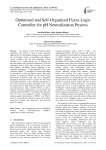
Optimized and Self-Organized Fuzzy Logic Controller for pH Neutralization Process
Статья научная
To conform to strict environmental safety regulations, pH control is used in many industrial applications. For this purpose modern process industries are increasingly relying on intelligent and adaptive control strategies. On one hand intelligent control strategies try to imitate human way of thinking and decision making using artificial intelligence (AI) based techniques such as fuzzy logic whereas on the other hand adaptive mechanism ensures adjusting of the controller parameters. A self-organized fuzzy logic controller (SOFLC) is intelligent in nature and adapts its performance to meet the figure of merit. This paper presents an optimized SOFLC for pH control using performance correction table. The fuzzy adaptation mechanism basically involves a penalty for the output membership functions if the controller performance is poor. The evolutionary genetic algorithm (GA) is used for optimization of input-output scaling factors of the conventional fuzzy logic controller (FLC) as well as elements of the fuzzy performance correction table. The resulting optimized SOFLC is compared with optimized FLC for servo and regulatory control. Comparison indicate superior performance of SOFLC over FLC in terms of much reduced integral of squared error (ISE), maximum overshoot and undershoot, and increased speed of response.
Бесплатно
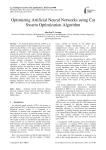
Optimizing Artificial Neural Networks using Cat Swarm Optimization Algorithm
Статья научная
An Artificial Neural Network (ANN) is an abstract representation of the biological nervous system which has the ability to solve many complex problems. The interesting attributes it exhibits makes an ANN capable of “learning”. ANN learning is achieved by training the neural network using a training algorithm. Aside from choosing a training algorithm to train ANNs, the ANN structure can also be optimized by applying certain pruning techniques to reduce network complexity. The Cat Swarm Optimization (CSO) algorithm, a swarm intelligence-based optimization algorithm mimics the behavior of cats, is used as the training algorithm and the Optimal Brain Damage (OBD) method as the pruning algorithm. This study suggests an approach to ANN training through the simultaneous optimization of the connection weights and ANN structure. Experiments performed on benchmark datasets taken from the UCI machine learning repository show that the proposed CSONN-OBD is an effective tool for training neural networks.
Бесплатно
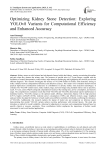
Статья научная
Kidney stones are solid mineral and salt deposits formed within the kidneys, causing excruciating discomfort and pain when they obstruct the urinary tract. The presence of speckle noise in CT-scan images, coupled with the limitations of manual interpretation, makes kidney stone detection challenging and highlighting the need for precise and efficient diagnosis. This research investigates the efficacy of YOLOv8 models for kidney stone detection, aiming to strike a balance between computational efficiency and detection accuracy. This study's novel evaluation framework and practical deployment considerations underscore its contributions to advance kidney stone detection technologies. It evaluates five YOLOv8 variants (nano, small, medium, large, and extra-large) using standard metrics such as precision, recall, F1-score, and mAP@50, alongside computational resources like training time, power consumption, and memory usage. The comprehensive evaluation reveals that while YOLOv8s and YOLOv8e demonstrate superior performance in traditional metrics, YOLOv8s emerges as the optimal model, offering a harmonious balance with its high precision (0.917), highest mAP@50 (0.918), moderate power consumption (150W), and efficient memory usage. Graphical analyses further elucidate the behaviour of each model across different confidence thresholds, confirming the robustness of YOLOv8s. Additionally, this research explores the impact of model size and complexity on inference speed, demonstrating that smaller YOLOv8 variants achieve real-time performance with minimal latency. The study also introduces a method for model scalability, allowing for adjustments in accuracy and computational demand based on specific clinical or resource constraints. These contributions further emphasize the importance of holistic model assessment for real-world medical applications.
Бесплатно
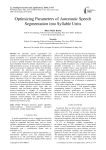
Optimizing parameters of automatic speech segmentation into syllable units
Статья научная
An automatic speech segmentation into syllable is an important task in a modern syllable-based speech recognition. It is generally developed using a time-domain energy-based feature and a static threshold to detect a syllable boundary. The main problem is the fixed threshold should be defined exhaustively to get a high generalized accuracy. In this paper, an optimization method is proposed to adaptively find the best threshold. It optimizes the parameters of syllable speech segmentation and exploits two post-processing methods: iterative-splitting and iterative-assimilation. The optimization is carried out using three independent genetic algorithms (GAs) for three processes: boundary detection, iterative-splitting, and iterative-assimilation. Testing to an Indonesian speech dataset of 110 utterances shows that the proposed iterative-splitting with optimum parameters reduce deletion errors more than the commonly used non-iterative-splitting. The optimized iterative-assimilation is capable of removing more insertions, without over-merging, than the common non-iterative-assimilation. The sequential combination of optimized iterative-splitting and optimized iterative-assimilation gives the highest accuracy with the lowest deletion and insertion errors.
Бесплатно
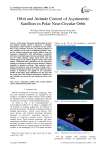
Orbit and Attitude Control of Asymmetric Satellites in Polar Near-Circular Orbit
Статья научная
In this paper, the general problem about the orbit and attitude dynamic model is discussed. A feedback linearization control method is introduced for this model. Due to the asymmetric structure, the orbital properties of such satellites are the same as traditional symmetric ones, but the attitude properties are greatly different from the symmetric counterparts. With perturbations accumulate with time, the attitude angles increase periodically with time, but the orbital elements change much slower than the attitude angles. In the attitude dynamic model, chaos could appear. Traditional linear controllers can not compensate enough for asymmetric satellite when the mission is complex, especially in maneuver missions. Thus nonlinear control method is required to solve such problem in large scale. A feedback linearization method, one robust nonlinear control method, is introduced and applied to the asymmetric satellite in this paper. Some simulations are also given and the results show that feedback linearization controller not only stabilizes the system, but also exempt the chaos in the system.
Бесплатно
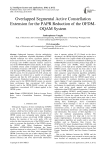
Overlapped Segmental Active Constellation Extension for the PAPR Reduction of the OFDM-OQAM System
Статья научная
Orthogonal frequency division multiplexing with Offset Quadrature Amplitude Modulation (OFDM-OQAM) technique has drawn significant interests in recent years. However, most of the existing OFDM peak-to-average ratio (PAPR) reduction schemes cannot be used in the OFDM-OQAM system directly. In this paper, a modified scheme called overlapped segmental Active Constellation Extension (OS-ACE) is proposed to deal with the high PAPR problem specifically in the OFDM-OQAM system. For the proposed OS-ACE scheme, the input signals are divided into a number of overlapped segments and then the ACE operation is processed on each segment. Simulation results show that the modified scheme used in the OFDM-OQAM system can provide better performance than conventional ACE scheme directly used in the OFDM-OQAM system, and even outperforms conventional ACE scheme applied in the OFDM system.
Бесплатно

PD Controller Structures: Comparison and Selection for an Electromechanical System
Статья научная
Many different PD controller modeling, configurations and control algorithms have been developed. These methods differ in their theoretical basis and performance under the changes of system conditions. In the present paper we review the methods used in the design of PD control systems. We highlight the main difficulties and summarize the more recent developments in their control techniques. Intelligent control systems like PD fuzzy control can be used to emulate the qualitative aspects of human knowledge with several advantages such as universal approximation theorem and rule-based algorithms.
Бесплатно
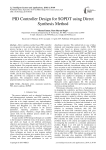
PID controller design for SOPDT using direct synthesis method
Статья научная
Direct synthesis method based PID controller was proposed for the second order plus dead time stable process having a zero in the numerator. The desired closed loop transfer function was considered as a second order time delay model and the Maclaurin series expansion technique was used to convert the obtained controller into the ideal form of the PID controller. The tuning parameter α was selected in such a way that gives the robustness level i.e. maximum sensitivity Ms value in the range of 1.2-1.8 which was the same as other recent tuning methods. The proposed method was applied to six different first and second order time delay process. The closed-loop performance in term of various performance indices such as settling time (ts), rise time (tr), Overshoot (%OS), and the time integral error indices such as IAE, ISE, and ITAE was compared to other similar design approaches. The comparative results show that the proposed method was superior to other methods.
Бесплатно

PLC based Smart Street Lighting Control
Статья научная
Conventional street lighting systems in most of the areas are Online at regular intervals of time irrespective of the seasonal variations. The street lights are simply switched on at afternoon and turned off in the morning. The consequence is that a large amount of Power is wasted meaninglessly. As energy consumption is an issue of increasing interest, possible energy savings in public street lighting systems are recently discussed from different viewpoints. The purpose of this work is to describe the Smart Street Lighting system, an approach to accomplish the demand for flexible public lighting systems using a Programmable Logic controller (PLC). The main difference from other computers is that PLCs are armoured for severe conditions such as dust, moisture, heat, cold etc., and have the facility for extensive input/output (I/O) arrangements. In the proposed paper, street lights are controlled using millennium 3 PLC taking the seasonal variations into consideration.
Бесплатно

PSO-Based NBI Resistant Asynchronous MC-CDMA Multiuser Detector
Статья научная
Nowadays with the increase of demand in multimedia communication, a reliable and error-free wireless communication system is the need of the hour. MC-CDMA is being investigated as a potential radio technology to provide fourth generation (4G) and fifth generation (5G) cellular mobile services. Narrowband interference (NBI) signals corrupts the subcarriers of MC-CDMA system and as a result its performance degrades. All the available NBI elimination methods uses some kind of filters and other circuitry prior to the demodulator (receiver) to filter out NBI. So addition of extra hardware to the system makes the system complex and slow. Moreover CDMA based systems are affected by digital NBI which gets superimposed with wideband spread spectrum signal. Multiuser detection could be an efficient technique to suppress NBI and multiple access interference (MAI). Computational complexity of opti-mum multiuser detector is an impediment in the way of an efficient multiuser detector. In this paper we propose a particle swarm optimization (PSO) based optimum multiuser detector to eliminate NBI. Simulation results show that performance of proposed PSO based multiuser detector is capable of eliminating NBI with much lesser amount of computational complexity.
Бесплатно
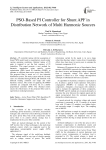
PSO-Based PI Controller for Shunt APF in Distribution Network of Multi Harmonic Sources
Статья научная
PI controller tuning with the assumption of linear PWM model leads to unsatisfactory results under varying operating conditions. Optimal tuning of PI gains is required to get the best response of PI controllers. This paper presents a new method for harmonic suppression using particle swarm optimization (PSO) based PI controller (PSOPI) to estimate an efficient shunt active power filter (SAPF). The proposed filter is tested on a 13 bus industrial distribution system. The study system with the 18 study cases are simulated through MATLAB Simulink with different loading condition and single and multi harmonic sources. The results of applying the PIPSO controller are compared with those out of a double proportional controller (DPC). The obtained results ensure the effectiveness of the proposed filter and its superiority in reducing harmonics.
Бесплатно
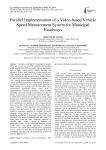
Parallel Implementation of a Video-based Vehicle Speed Measurement System for Municipal Roadways
Статья научная
Nowadays, Intelligent Transportation Systems (ITS) are known as powerful solutions for handling traffic-related issues. ITS are used in various applications such as traffic signal control, vehicle counting, and automatic license plate detection. In the special case, video cameras are applied in ITS which can provide useful information after processing their outputs, known as Video-based Intelligent Transportation Systems (V-ITS). Among various applications of V-ITS, automatic vehicle speed measurement is a fast-growing field due to its numerous benefits. In this regard, visual appearance-based methods are common types of video-based speed measurement approaches which suffer from a computationally intensive performance. These methods repeatedly search for special visual features of vehicles, like the license plate, in consecutive frames. In this paper, a parallelized version of an appearance-based speed measurement method is presented which is real-time and requires lower computational costs. To acquire this, data-level parallelism was applied on three computationally intensive modules of the method with low dependencies using NVidia’s CUDA platform. The parallelization process was performed by the distribution of the method’s constituent modules on multiple processing elements, which resulted in better throughputs and massively parallelism. Experimental results have shown that the CUDA-enabled implementation runs about 1.81 times faster than the main sequential approach to calculate each vehicle’s speed. In addition, the parallelized kernels of the mentioned modules provide 21.28, 408.71 and 188.87 speed-up in singularly execution. The reason for performing these experiments was to clarify the vital role of computational cost in developing video-based speed measurement systems for real-time applications.
Бесплатно

